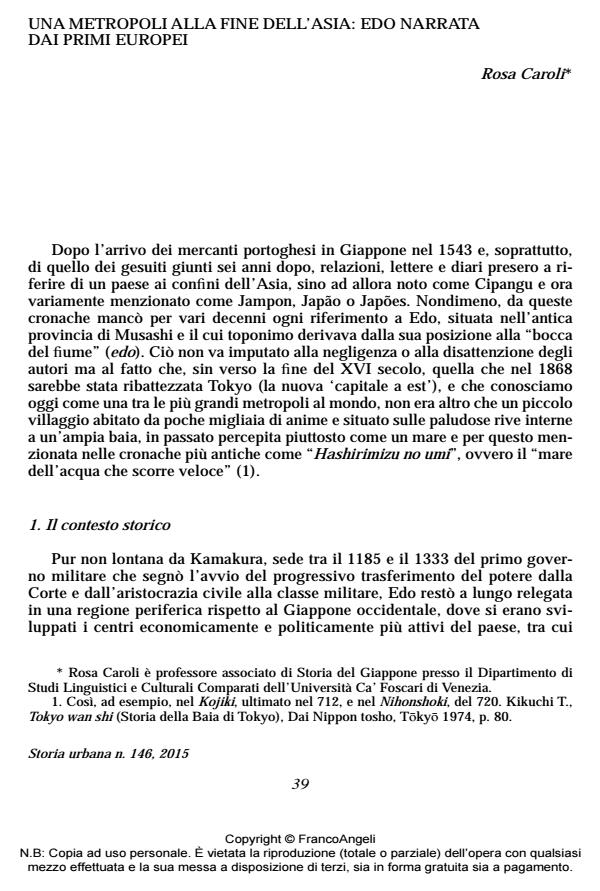A metropolis at the end of Asia. Edo narrated by the fi rst Europeans Japan, History (16th – 17th centuries)
Journal title STORIA URBANA
Author/s Rosa Caroli
Publishing Year 2015 Issue 2015/146
Language Italian Pages 30 P. 39-68 File size 448 KB
DOI 10.3280/SU2015-146003
DOI is like a bar code for intellectual property: to have more infomation
click here
Below, you can see the article first page
If you want to buy this article in PDF format, you can do it, following the instructions to buy download credits

FrancoAngeli is member of Publishers International Linking Association, Inc (PILA), a not-for-profit association which run the CrossRef service enabling links to and from online scholarly content.
Until the end of the XVI century, Edo (the old Tokyo) was little more than a village inhabited by some thousands people. Yet, over about one century, it became the largest city in the world, where about one million people lived more or less permanently. The engine of the fast development of the town was the so-called "alternate attendance" (sankin kōtai) that the Tokugawa imposed on the feudal rulers of all the country after Edo became the seat of the military power under the Tokugawa clan in 1603. This practise required them to move periodically between their fi efs and Edo, typically spending alternate period in each place. During his journeys to and from Edo, feudal lords were escorted by hundreds persons; besides, during their absence from Edo, they were required to leave as hostages their wives, heirs, offi cials and retainers in mansions that they had to build, maintain and - due to the high incidence of fi res - often rebuild. The presence of this rich and demanding elite, which consumed without producing, increasingly polarised wealth, goods and people in Edo, making it the Japan’s capital of consumerism. This essay considers the descriptions of Edo left by European authors who visited the city before a series of edicts enforcing the expulsion of Europeans missionaries and merchants from the country in the 1630s. Their accounts describe a city which was still under construction, was mainly inhabited by male militaries and workers, and only partially populated by those commoners who would have occupied the ‘low city’ and were both the authors and subjects of a rich and original popular culture. This multilingual narration, fi ltered through Europeans eyes, provides a vision of Edo before the great fi re of Meireki (1657) cancelled many traces of the original town and caused a re-planning of the urban spaces, in a phase when European idea of Japan was not yet affected by those racial discourses and colonial practises which would have placed Japan in the Europe’s Orient and turned the Japanese people into a yellow race.
Keywords: Edo (Tokyo), Urban history Europe, Descriptions and voyages, Japan Cities and towns, Japan, History
Rosa Caroli, Una metropoli alla fine dell’asia: Edo narrata dai primi europei in "STORIA URBANA " 146/2015, pp 39-68, DOI: 10.3280/SU2015-146003